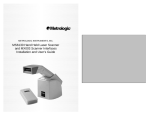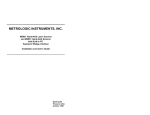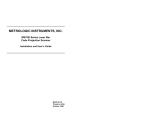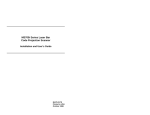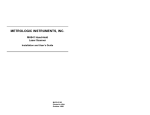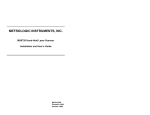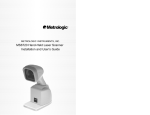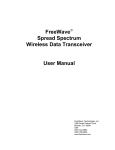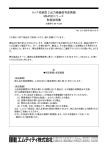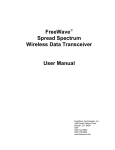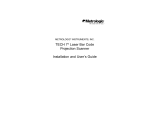Download Metrologic MS6130 User`s guide
Transcript
METROLOGIC INSTRUMENTS, INC. MS6130 Hand Held Laser Scanner and MX003 Scanner Interfaces Installation and User’s Guide LOCATIONS North America Headquarters Metrologic Instruments, Inc. 90 Coles Road Blackwood, NJ 08012-4683 Customer Service: 1-800-ID-METRO Tel: 856-228-8100 Email: [email protected] Website: www.metrologic.com Germany Metrologic Instruments GmbH Dornierstrasse 2 82178 Puchheim b. Munich, Germany Tel: 49-89-89019-0 Fax: 49-89-89019-200 Email: [email protected] South America Metrologic South America Rua Flórida 1821 - 5° Andar São Paulo, SP, Brasil CEP: 04571-090 Tel: 5511-5505-6568 Fax: 5511-5505-1681 Email: [email protected] Brazil Metrologic do Brasil Ltda Rua Flórida 1821 - 5° Andar São Paulo, SP, Brasil CEP: 04571-090 Tel: 5511-5505-2396 Fax: 5511-5507-2301 Email: [email protected] Asia Metrologic Asia (Pte) Ltd 31, Kaki Bukit Road 3 #05-08 Techlink Singapore 417818 Tel: 65-842-7155 Fax: 65-842-7166 Email: [email protected] Copyright © 2000 by Metrologic Instruments, Inc. All rights reserved. No part of this work may be reproduced, transmitted, or stored in any form or by any means without prior written consent, except by reviewer, who may quote brief passages in a review, or provided for in the Copyright Act of 1976. Products and brand names mentioned in this document are trademarks of their respective companies. MLPN 2212 Printed in USA February 2000 ii TABLE OF CONTENTS MS6130 Hand Held Bar Code Scanner..................................................... 1 MX003 Series Scanner Interfaces............................................................. 2 Unpacking List ......................................................................................... 3 Connections of the “MX” Interface to the Host Device................................ 4 Connections of the Keyboard Wedge “MX” Interface to the PC .................. 5 Connections of the MS700i/MS720i with “MX” to the Host Device .............. 6 Configuration of the MS700i/MS720i with “MX”.......................................... 7 Configuration of the MS700i/MS720i with “MX” to the Host System............ 8 Configuration of the “MX” to the ScanPal® Data Collector .......................... 9 Configuration of the “MX” to the RS-232 Light Pen or Keyboard Wedge Host System ............................................................................. 10 Keyboard Wedge (KB) Interface ............................................................. 11 Configuration of the MS6130 Hand-Held ................................................. 15 Enabling the MS700i/MS720i Scanner’s RF Low Speed Option ............... 16 Changing the ID ..................................................................................... 17 Matching Procedure ............................................................................... 18 Parts of the MS6130 Hand-Held Bar Code Scanner ................................ 19 Components of the MS6130 Series Stand............................................... 20 Installation of the MS6130 Series Stand.................................................. 21 Installation of the 6000 Series Universal Charging Stand......................... 22 NiCd Battery Charger with Reconditioning Feature.................................. 23 Visual Indicators..................................................................................... 24 Audible Indicators................................................................................... 25 Labels.................................................................................................... 27 iii TABLE OF CONTENTS (CONTINUED) Maintenance .......................................................................................... 27 Troubleshooting ..................................................................................... 28 Appendix A Specifications ........................................................................... 29 Appendix B Default Settings of the MS6130 and “MX” Interface ................... 32 Appendix C MX003 Series Scanner Interface Pin Assignments..................... 36 Appendix D Warranty and Disclaimer ........................................................... 37 Appendix E Notices ..................................................................................... 38 Appendix F Patents..................................................................................... 39 Index ..................................................................................................... 40 iv Printer Note: Leave page blank. THE MS6130 HAND HELD BAR CODE SCANNER MS6130 Hand Held Bar Code Scanners are wireless scanners with a mobility range of up to 30 feet from the receiver. When not in use, the scanner rests in a universal-charging stand. The scanner will be fully charged in 2 hours when not scanning in the stand. A fully charged MS6130 can provide up to 8 hours of wireless, hand-held scanning. After dormant periods, the scanner is programmed to enter a timeout mode that will extend the battery life. There is a reactivation switch conveniently located on the side of the scanner to turn the unit back on. The scanner has a replaceable battery pack for added reliability and convenience for your scanning application. Metrologic’s scanner uses wireless data communication to transfer information to the host. The MS6130 may be used with Metrologic’s MX003 Series Scanner Interfaces to provide the short range, one-way communication link between the scanner and an RS-232, Keyboard Wedge or Light Pen host device. The MS6130 uses Metrologic’s patented Infrared Object Sensor for triggerless operation. The scanner, after a specified time, will enter a standby mode where the VLD and motor will shut off. Simply present an object in front of the scanner window, the Infrared Sensor will reactivate the scanner and the unit will be ready to scan. To indicate the status of the scanner, the MS6130 uses a green and red LED located on the top of the scanner. By understanding the flashes of the LED, you can determine a successful read, laser status, low battery power, sleep mode, and program mode. There are audible indicators on the scanner as well. The scanner will beep; one, two or three times to indicate successful power up or scan, low battery, or program mode, respectively, or give a razzberry tone; which indicates the scanner has failed diagnostics upon power up. In this manual, the MS6130 may be referred to as the scanner or transmitter. 1 MX003 SERIES SCANNER INTERFACES Metrologic’s MX003 Series Scanner Interfaces provide a short range, oneway wireless data communication link between a remote portable scanner and an RS-232 or light pen host device. Specifically, Metrologic’s MS6130 Hand-Held Laser Scanners include a Liberty® RF transmitter board. Metrologic’s MS700i/MS720i series scanners, TECH series scanners may be connected to a MX Series scanner interface. The “MX” scanner interface includes a RF receiver and a digital interface board. The MS6130 scanner provides two functions: • • Scans and decodes bar codes Transmits scanned data to the RF receiver or “MX” When the “MX” interface is connected to a ScanPal® or host device such as a portable data terminal (PDT), it provides two functions (For example, refer to Figure 1): • • Performs the RF receiver function; for example, beeps to show it has received data from the transmitter Communicates with the host device In this manual, MX003 series scanner interfaces may be referred to as the “MX”, “MX” interface or receiver. Suffix of the MX003 model designation will vary due to country of usage. Any RS-232C or Light Pen Device with MX003 RF Receiver MS6130 with Liberty® RF Scanner Interface (Transmitter) Up to 30 Ft. (conditions permitting) Figure 1 2 UNPACKING LIST Your shipment will contain a set of items from the two groups listed below: Transmitter Group: • • • • MS6130 Hand-Held Scanner Stand #45880 (optional) Stand #45558, 45559 and 45560 (optional) MS4120 Programming Guide Receiver Group: • “MX” Scanner Interface • MCA951 adapter or adapter cable (if required) • Regulated 5V power supply, MLPN: 6090/6091 (115/220 VAC)(optional) OR • • • • “MX” Scanner Interface MS700i with Liberty® RF Receiver option cable Power supply (optional) Communication cable with connection for power supply (optional) or communication cable only • Stand #45483 (optional) • MS700i and MS720i Installation and User’s Guide • ScanSelect™ Scanner Programming Guide (#2186) OR • • • • • • ScanPal® Data Collector “MX” Scanner Interface Upload cable, MLPN: 51061 and 51236 MCA951 adapter Regulated 5V power supply, MLPN: 6090/6091 (115/220 VAC) ScanPal Data Collector Installation and User’s Guide 3 CONNECTIONS OF THE “MX” INTERFACE TO THE HOST DEVICE Except version 17 1. Turn off the host system. 2. Connect the MCA to the host device. Connect the “MX” interface to the MCA. 3. Check the AC input requirements of the transformer to make sure the voltage matches the AC outlet. The socket outlet should be near the equipment and easily accessible. 4. Plug the transformer into the side of the MCA and the AC outlet. 5. Power up the host system. MS6130 with Liberty® RF Scanner Interface (Transmitter) Transformer “MX” Scanner Interface MCA Host System Figure 2: Connecting the “MX” (through the MCA) to a host device To maintain compliance with applicable standards, all circuits connected to the unit must meet the requirements for SELV (Safety Extra Low Voltage) according to EN 60950. 4 CONNECTIONS OF THE KEYBOARD W EDGE “MX” INTERFACE TO THE PC Version 17 only MX003 Scanner Interfaces with a suffix of “17" are Keyboard Wedge versions used to interface with a PC and keyboard. 1. Turn off the PC. 2. Plug the “MX” receiver adapter cable to the PC keyboard port. 3. Plug the keyboard into the “MX” receiver adapter cable. 4. Power up the PC. MS6130 with Liberty® RF Scanner Interface (Transmitter) Optional Adapter “MX” Receiver adapter Cable Host System Figure 3: Connecting the “MX” to a PC and keyboard To maintain compliance with applicable standards, all circuits connected to the unit must meet the requirements for SELV (Safety Extra Low Voltage) according to EN 60950. The following statement is applicable if the scanner will receive power from a host device such as a computer system. Caution: To maintain compliance with standards CSA C22.2 No. 950/UL 1950 and norm EN60950, the power source must meet applicable performance requirements for a limited power source. 5 CONNECTIONS OF THE MS700I/MS720I WITH “MX” TO THE HOST DEVICE To avoid potential problems, do not power up the scanner until the communication cable is secured to the host. 1. Turn off the host system. 2. Connect the 25-pin D-type connector on the MS700i/MS720i scanner’s head cable to the communication cable. Connect the other end of the communication cable to the host device. If the scanner will not receive power from a transformer, skip to Step 5. 3. If the scanner will receive power from an external power source, check the AC input requirements of the transformer to make sure the voltage matches the AC outlet. The socket-outlet should be near the equipment and easily accessible. 4. Plug the transformer into the side of the female D-type connector located on the communication cable. Plug the transformer into the AC outlet to supply power to the scanner. 5. Power up the host system. 6. Attach the “MX” to the MS700i/MS720i scanner via the LSO cable that terminates to a 10-pin modular connector. Note: When the MS700i/MS720i scanner first receives power, the LEDs will flash and then the scanner will beep once. After the scanner performs this startup sequence, the green LED will remain on for a specified time showing that the laser is on. Refer to the MS700i and MS720i Laser Bar Code Projection Scanner Installation and User’s Guide for information on how to operate the scanner. To maintain compliance with applicable standards, all circuits connected to the unit must meet the requirements for SELV (Safety Extra Low Voltage) according to EN 60950. The following statement is applicable if the scanner will receive power from a host device such as a computer system. Caution: To maintain compliance with standards CSA C22.2 No. 950/UL 1950 and norm EN60950, the power source must meet applicable performance requirements for a limited power source. 6 CONFIGURATION OF THE MS700I/MS720I WITH “MX” To perform matching procedure refer to page 18. Once the transmitter is assigned an ID number, configure the S700i/MS720i to accept RF communication. Although the changes made in this section effect the receiver, the MS6130 performs all scanning. 1. Scan the following bar code to enter the receiver’s program mode. (The MS700i/MS720i will beep three times): Enter/Exit Program Mode for the Receiver 0 2. 1 2 3 4 5 6 6 6 6 6 7 Enable the RF interface by scanning the following bar codes in order: R 0 1 L P 1 H H 1 3. Exit program mode by scanning the bar code in Step 1 again. 4. Proceed to the procedure on the next page. 7 CONFIGURATION OF THE MS700I/MS720I WITH “MX” TO THE HOST SYSTEM To perform matching procedure refer to page 18. Before the MS700i/MS720i scanner ships from the factory, the factory programs the scanner to a group of default settings noted in the ScanSelect™ Scanner Programming Guide. An asterisk marks each default setting. The asterisk appears before the brief definition located near the bar code. Once RF communication establishes, change the default settings of your scanner to meet your individual scanning needs or your host system’s communication requirements. Modify the scanner's settings by entering the program mode and scanning the appropriate bar codes that appear in the ScanSelect Scanner Programming Guide. Note: When the Load Defaults bar code in the ScanSelect Scanner Programming Guide is chosen, it will automatically disable the RF low speed option. For the MS6130 to communicate to the MS700i/MS720i scanner, re-enable the RF Low Speed Option (refer to the procedure above). 8 CONFIGURATION OF THE “MX” TO THE SCANPAL® DATA COLLECTOR To perform matching procedure refer to page 18. The RS-232 parameters marked with an asterisk ( * ) in the charts are the default settings of the “MX”. The charts are in the Default Settings of the MS6130 and “MX” Receiver section of this guide. To communicate with each other properly, the “MX” and ScanPal must have matching RS-232 parameters. However, the Enter/Exit Program Mode bar code in the MS4120 Programming Guide will not cause your “MX” to enter or exit program mode. Scan the Enter/Exit Program Mode for the Receiver bar code in the following procedure. Before completing RF communication, program the ScanPal to the same settings as the IBM® PC XT, AT or PS/2 compatible computer. Once completed and the receiver and MS6130 have the same assigned ID number, configure the “MX” to the same settings as ScanPal. 1. Program the ScanPal to the same settings as the PC. (Refer to the Programming the ScanPal section in the ScanPal® Data Collector Installation and User’s Guide) 2. Scan the following bar code to enter program mode. (The “MX” receiver will beep three times): Enter/Exit Program Mode for the Receiver 0 12 3 45 6 66 66 7 3. Scan the appropriate communication options in the MS4120 Programming Guide. 4. Exit program mode by scanning the bar code in Step 1 again. Note: Scan the Enter/Exit Program Mode for the Receiver bar code and exit program mode if the PC uses the same parameters as the default settings of ScanPal. Default to ScanPal Communication Parameters I B 5 9 CONFIGURATION OF THE “MX” TO THE RS-232, LIGHT PEN OR KEYBOARD WEDGE HOST SYSTEM To perform matching procedure refer to page 18. The light pen, RS-232 and Keyboard Wedge parameters marked with an asterisk ( * ) in the charts are the default settings of the “MX”. The charts are in the Default Settings of the Transmitter and “MX” Receiver section of this guide. To communicate with a host system properly, program the “MX” to match the host system’s requirements. However, the Enter/Exit Program Mode bar code in the MS4120 Programming Guide will not cause your “MX” to enter or exit program mode. Scan the Enter/Exit Program Mode for the Receiver bar code in the following procedure. Once the MS6130 is assigned an ID number, configure the “MX” to the correct communication protocol. 1. Scan the following bar code to enter program mode. (The “MX” receiver will beep three times): Enter/Exit Program Mode for the Receiver 0 2. 12 3 45 6 66 66 7 Scan the following bar code to confirm the receiver is using the original factory settings. Recall Defaults D F 1 3. Scan the appropriate communication options in the MS4120 and MS951 Programming Guides. 4. Exit program mode by scanning the following bar code. (The “MX” receiver will beep three times): Enter/Exit Program Mode for the Receiver 0 10 12 3 45 6 66 66 7 KEYBOARD WEDGE (KB) INTERFACE Scan the ENABLE KB WEDGE INTERFACE bar code if your communication requirement is keyboard emulation. The scanner will provide keyboard emulation by converting the scanned bar code data to the PC keyboard scan code equivalent. Enable Keyboard Wedge Interface R 2 4 KB Parameter - Keyboard Type The following bar codes are used to define the type of keyboard in use. If necessary, scan the appropriate bar code. ** AT Keyboard (includes IBM® PS/2: Models 50, 55, 60, 80) L P 3 XT Keyboard L P 4 Enable IBM PS/2 Keyboard (Models 30, 70, 8556) S H 4 ** Disable IBM PS/2 Keyboard (Models 30, 70, 8556) S H 3 Enable Single-Ended Keyboard Emulation R 5 7 11 KEYBOARD WEDGE (KB) INTERFACE (CONTINUED) KB Parameter – Keyboard Type The following bar codes are used to define the keyboard country type. If necessary, scan the appropriate bar code. ** USA Keyboard B R 8 UK Keyboard B R 2 France Keyboard B R 3 Germany Keyboard B R 4 Italy Keyboard B R 5 Spain Keyboard B R 6 Belgium Keyboard B R 1 IBM KB4700 Financial Keyboard B R 7 Swiss Keyboard B R 9 Reserved B 12 R A KEYBOARD WEDGE (KB) INTERFACE (CONTINUED) Reserved B R B Reserved B R C Reserved B R D Reserved B R E Reserved B R F KB Parameter - Caps Lock Mode When Caps Lock is used on the keyboard, choose ENABLE CAPS LOCK. Once enabled, the scanner will simulate Caps Lock keyboard input. This mode will not work with all keyboard types. Enable Caps Lock R 6 **Disable Caps Lock R To detect automatically if Caps Lock is used, enable AUTO-DETECTION CAPS LOCK MODE. This will only work with an AT computer. 4 4 7 Enable Auto Detection Caps Lock Mode R 6 8 **Disable Auto Detection Caps Lock Mode R 6 9 13 KEYBOARD WEDGE (KB) INTERFACE (CONTINUED) KB Parameter - Alt Mode When this option is enabled, the scanner will duplicate this keyboard sequence: Hold down the Alt key; type the decimal number that corresponds to the appropriate keyboard character. Caution should be observed when using Alt mode because a scanner to host application conflict may occur if the host software application uses the Alt key as a “Hot” key. Enable Alt Mode H H 3 **Disable Alt Mode H H 4 KB Parameter - Inter Scan Code Delay (AT and PS/2 Modes) The time specified with an interscan code ** 800 Microsecond Delay delay bar code represents the amount of time between individual 9 bit scan codes. Each character of a bar code takes between two O C 8 and twelve of these scan codes to be passed through to the PC via the keyboard interface. This parameter may need to be adjusted for operation with certain PC keyboard BIOS’s. Network operating systems often use 7.5 Millisecond Delay microprocessor time slices to service network information requests instead of the keyboard interface. While not an issue with manually O C 9 entered keystrokes, this timing can be critical with automatic scanner data entry. Interscan code delays can be a useful system tuning tool in these environments. 15 Millisecond Delay O KB Parameter - XT - Clean-Up Bit Some keyboard BIOS's require a "cleanup bit" to be transmitted before an actual scan code being clocked over to the motherboard. Enabling this feature will cause the scanner to send this extra bit to the host computer. More commonly found on older XT style BIOS's, and some AT BIOS's. (required by some NEC 80286 machines). 7 Enable Cleanup Bit H H 1 ** Disable Cleanup Bit H 14 C H 2 CONFIGURATION OF THE MS6130 HAND-HELD To perform matching procedure refer to page 18. Before the MS6130 scanner ships from the factory, the factory programs the scanners to a set of default settings. These default settings can be found in the MS4120 Programming Guide. The default settings have an asterisk that appears before the brief definition located near the bar code. Once RF communication establishes, change the default settings of your scanner to meet your individual scanning needs. Configure the scanner by scanning the Transmitter Enter/Exit Program Mode bar code and the appropriate bar codes in the MS4120 Programming Guide. For example, to program the MS6130 not to read ITF (Interleaved 2 of 5) bar code types: • With the MS6130, scan the Enter/Exit Program Mode bar code in the MS4120 Programming Guide, the Disable ITF bar code, then the Enter/Exit Program Mode bar code again. Note: When the MS6130 is in program mode, never scan any of the RS-232 or light pen options marked with an “R”. The list of options is in the Default Settings of the Transmitter and “MX” Receiver section of this guide when using the MS4120 Programming Guide. The MS6130 is in program mode when scanning the Enter/Exit Program Mode bar code in the MS4120 Programming Guide. 15 ENABLING THE MS700I/MS720I SCANNER’S RF LOW SPEED OPTION Before beginning this procedure, perform all steps in the sections, Matching the Transmitter to the Receiver and Configuration of the MS700i/MS720i with “MX”. Use the MS700i/MS720i scanner to scan the following bar codes. 1. Temporarily cover the bar code below Step 3. Scan the following bar code to enter program mode. (The MS700i scanner will beep three times): Enter/Exit Program Mode for the Receiver 0 12 3 45 6 66 66 7 2. Temporarily cover the bar code in Step 1. Scan the Enable RF Low Speed Option bar code below Step 3. 3. Exit program mode by scanning the bar code in Step 1 again. Enable RF Low Speed Option 0 16 12 3 45 1 29 15 5 CHANGING THE ID In order for the MS6130 to send data to the correct receiver, they must have a matching ID number. The ID number is the serial number of the receiver. When the matching procedure is completed, the receiver will accept data only from a MS6130 that has the matching ID number. Each receiver is programmed with its serial number before it leaves the factory. 1. To program a new ID for the receiver, HANDSET (Version 1.14 or greater) must be used. Type the following at the DOS prompt: HANDSET /X 2. Power up the receiver, but DO NOT scan any bar codes. 3. Select “Enter Program Mode”. Select the appropriate SERIAL PORT (COM 1 or COM 2) on the PC. Make sure the Receiver is connected to the SERIAL PORT selected. 4. Select “Get Scanners Settings”. A screen will appear showing all of the options available. 5. Using the arrow keys, move down to the section labeled “Metro ID#”. Locate the serial number on the case of the receiver. Enter this 10digit number into the “Metro ID#” section. 6. Press the “F5" key to program the receiver. 7. The receiver will beep when programming is completed. The receiver is now programmed with its proper ID. Exit HANDSET by pressing “F9" and then press “7". 8. Power Down the receiver. 17 MATCHING PROCEDURE With the MS6130, scan the following bar codes starting from the top down: Transmitter Enter/Exit Program Mode * * Recall Defaults D F 1 Enable RF Communications R 3 5 Transmitter Enter/Exit Program Mode * * Locate the model label on the case of the receiver. Scan the serial number bar code. The receiver and MS6130 are now matched. For information on how to configure the receiver, refer to the appropriate section in this guide. Note: If using more than one MS6130 with one receiver, perform the above procedure for each MS6130. Since each MS6130 has the same ID number, the receiver will accept data from all of the scanners 18 PARTS OF THE MS6130 HAND-HELD BAR CODE SCANNER Becoming familiar with the features of the MS6130 hand-held scanner will help when operating one of these scanners. The illustration and list explain the pertinent parts. Green and Red LED Replaceable Battery Pack Output Window Battery Charge Contacts Reactivation Switch Infra-red (IR) Sensor Figure 4: Scanner Parts Battery Charge Contacts Receptacle for the battery charger. Reactivation Switch Turns the unit on after a timeout. Press the button from the bottom. Green and Red LEDs When the red LED is on, the laser is on. If the green LED flashes on, the scanner has read a bar code successfully. Communication to the host is complete when the receiver beeps. Infrared Object Sensor When a specified time has elapsed without any scanning, the unit will enter a “standby” mode. To reactivate the unit, remove the current object and present an object in front of the output window again. Output Window This aperture emits laser light. 19 COMPONENTS OF THE MS6130 SERIES STAND The following are the components used to build the MS6130 series stand (MLPN: 45880). 1 1. Cradle 2. Stand Charger Pack 3. Pole Cover 2 10 8 3 4. Flex pole 5. Stand Base Cover 6. Stand Base 7. Charger Transformer 8. Charger Pack Screws CABLE CONNECTS THROUGH OPENING 4 7 5 9. Mounting Screws 9 10. Lock Washer 6 Figure 5: Scanner Parts 20 INSTALLATION OF THE MS6130 SERIES STAND Refer to for numbered components on the previous page 1. Use the stand base (6) as a template to drill and mount the base to the counter using the mounting screws (9) provided. 2. Feed the wire from the transformer (7) through the slot in the base cover (5) approximately 9" of the wire. 3. Press the base cover (5) over the base (6). 4. Attach the flex pole (4) to the base (6). 5. Slide the flex cover (3) over the pole (4) and wire. 6. Attach the cradle (1) to the flex pole (4) using the lock washer (10) to connect the transformer. 7. Insert the transformer plug into the connector inside the stand charger pack (2). 8. Clip the charger pack to the bottom of the cradle (1) lock in place using two screws (8). Stand LED Indicators (with the scanner in the stand) No LED indicates trickle charge and the green LED indicates fast charge. To change from trickle charge to fast charge, simply lift the scanner from the stand and replace. Note: When both scanner LEDs blink, it is an indication of a low battery. 21 INSTALLATION OF THE 6000 SERIES UNIVERSAL CHARGING STAND MLPN: 45558 - 115V, 45559 - 230V and 45560 - 240V (UK) Transformer Green LED (Charge Status) Red LED (Power) Figure 6: Universal Charging Stand PERMANENT COUNTER TOP INSTALLATION 1. Separate weighted base from rotating base by removing the (4) four screws. 2. Use the rotating base as a drill template. 3. Use the (4) four wood screws provided to mount the base to the counter top securely. 4. Snap the cup assembly to the base. Note: For non-permanent installation, snap the cup assembly onto the weighted base CHARGE STATE 22 CHARGE LED STATUS Battery Absent LED off Charge Pending LED on for 0.125sec, off for 1.375sec Fast-Charge LED on Charge Complete and Top-Off LED on for 0.125 sec, off for 0.125sec NICD BATTERY CHARGER WITH RECONDITIONING FEATURE MLPN: 45561 - 115V and 45562 - 230V How to Recondition Transformer Discharge Cycle Switch 1. Place the scanner into the charge stand. 2. Push the stand tilt cup in the extreme down position to expose the hole for the discharge cycle switch. Red LED (Power) Green LED (Charge Status) Figure 6: Reconditioning 3. Use a pin to push the discharge cycle switch located beneath the hole. 4. When the discharge mode is initiated the green LED flashes. RECOMMENDED USE To maintain charge capacity, the NiCd batteries must be discharged fully before charging. We call this process reconditioning. Recondition if: • The batteries were not used within 20 days • The batteries were not discharged (approximately two hours of continuous operation) at least once a week • Low battery indicators: • Both LED’s on the scanner blink • The scanner quietly beeps twice while scanning Recondition once a week if: • The batteries do not get discharged for more than 20% (approximately ½ hour) of their capacity before recharging. Recondition once every two weeks if: • The batteries do not get discharged for more than 50% (approximately 1 hour) of their capacity before recharging. Note: The day to day usage of the NiCd batteries will determine the frequency of the discharges (reconditioning). Charge State Battery Absent CHG LED Status LED off Discharge-BeforeCharge Fast-Charge LED on for 0.125sec, off for 1.375sec LED on for 1.375sec, off for 0.125sec LED on Charge Complete TopOff LED on for 0.125 sec, off for 0.125sec Charge Pending 23 VISUAL INDICATORS The scanner has red and green LEDs. When the scanner is on, the LEDs indicate the status of the scan and scanner. No Red or Green The scanner will turn off if the scanner has been dormant for a specified time. To reactivate the unit, direct the output window up then down toward the bar coded product. If the unit has been dormant for longer than 10 minutes, reactivating the unit by pressing the button on the side of the MS6130 will be necessary. Red Flash; Green Flash; When the scanner first receives power, the steady red LED will flash, followed by the green LED. Steady Red When the laser is on, the red LED will also be on. This occurs when an object is in the scan field. If the scanner does not detect a bar code within approximately 2.5 seconds, the red LED will shut off indicating that the laser is no longer on. If the red LED remains on for longer than 7.5 seconds, then the scanner is in program mode. Steady Red; Green Flash When the scanner successfully reads a bar code, the green LED will flash. If the green LED does not flash, then the bar code read was not successful. Repetitive Red Flashes When the red LED flashes several times while it lays upon a stationary surface, then an object is within the scan field and is activating the IR sensor. This can occur even while the scanner is lying upon the counter or cradle. To eliminate this disturbance, direct the scan window toward a different location. 24 AUDIBLE INDICATORS When the scanner and “MX” receiver are in operation, they provide audible indications. These sounds indicate the status of the scan and scanner. One Beep When the “MX” Receiver first receives power, the unit will beep once. If the scanner successfully reads a bar code, the green light will flash. If the “MX” receiver successfully receives the data from the MS6130, the “MX” will beep once. Razzberry Tone If, upon power up, the scanner emits a razzberry tone, then the scanner has failed diagnostics. The “MX” receiver will emit a razzberry tone if an invalid bar code is scanned while the receiver is in program mode. The “MX” receiver can be programmed to emit a razzberry tone when the timeout occurs during communication between the host and receiver. Refer to the MS4120 Programming Guide section, Audible Indicators for Communication Timeouts to program this feature. Two Beeps The MS6130 scanner will quietly beep twice when scanning a bar code if the batteries become low. Three Beeps When scanning the MS6130 Enter/Exit Program Mode bar code in the MS4120 Programming Guide, the green LED will flash three times while the scanner simultaneously beeps three times. When exiting the program mode, the same visual and audible indications will occur. After this sequence is completed, the red LED will turn off. When scanning the Enter/Exit Program Mode for the Receiver bar code, the “MX” receiver will beep three times to indicate it is in or exiting out of the program mode. (continued next page) 25 AUDIBLE INDICATORS (CONTINUED) The “MX” receiver can be programmed to emit three beeps when the timeout occurs during communication between the host and receiver. Refer to the MS4120 Programming Guide section, Audible Indicators for Communication Timeouts to program this feature. There are four settings available for the tone of the beep for the receiver. Refer to the MS4120 Programming Guide section, Beeper Tones to program the feature to change the tone or turn the beeper off. 26 LABELS The MS6130 scanner is either a CDRH Class II laser system or an IEC Class 1 Laser System. Your unit will have a CDRH Class II caution label or LASERKLASSE 1 label affixed below the model number label. The model number/avoid exposure label is located on the bottom of the scanner’s head. The following are examples of these labels: MAINTENANCE Smudges and dirt can interfere with the proper scanning of a bar code. Therefore, the output window will need occasional cleaning. 1. Spray glass cleaner onto lint free, non-abrasive cleaning cloth. 2. Gently wipe the output window. 27 TROUBLESHOOTING 1. The receiver can receive data from a MS6130 with its own ID or 10 zeroes. It’s own ID can be received all the time. When using 10 zeroes, the first scan the receiver gets must have 10 zeroes as its ID and from that point on the receiver will accept both ID’s. Power down the receiver. Using the MS6130, scan the bar codes from section 9 in the Matching MS6130 to the Receiver section and use the following bar code as the ID number. Scanner ID Number 0 0 0 0 0 0 0 0 0 0 Note: Use this bar code for troubleshooting purposes only. 2. Power up the receiver. 3. If the user is trying to match a new ID to the receiver and the receiver is powered up, the receiver will beep 3 times if the ID number it receives matches its current ID. 4. When the MS6130 is in program mode, never scan any of the RS-232 or light pen options marked with an “R”. The list of options is in the Default Settings of the MS6130 and “MX” Receiver section of this guide when using the MS4120 Programming Guide. The MS6130 is in program mode when scanning the Enter/Exit Program Mode bar code in the MS4120 Programming Guide. If a receiver option is chosen while the MS6130 is in program mode, RF communication between the MS6130 and receiver may terminate. If this occurs, the only way to reestablish RF communication is by performing all the RF configuration procedures again. 28 APPENDIX A Specifications RF Link Characteristics Frequencies: One of the following depending on the country of operation: 418MHz 434MHz 912MHz Bandwidth: 220kHz Modulation: FM Certification: No FCC licensing required RF Protocol: One way data transmission Transmission time at a maximum of 100 ms 50K baud data rate Dedicated transmitter(s) to receiver link Operating Range: Up to 30 feet (conditions permitting) Specifications subject to change without notice MS6130 Bar Code Scanner Specifications UL Listed: US and Canada FCC ID: LW5613 (912MHz only) RF Output Power: 20 uW max. (912MHz only) Current: Supplied by rechargeable/replaceable batteries Antenna: Integral Dimensions: 205mmL x 63mmW x 24mmH Weight: 10.5 Oz Maximum Radiant Power: 0.9mW Peak VLD Wavelength: 675nm ± 5nm 29 APPENDIX A (CONTINUED) MX003 Series Scanner Interface Specifications FCC ID: LW5003 Operating Voltage: 5Vdc Antenna: Integral Dimensions: 3.54" x 1.97" x 0.94" Weight: 0.175 lb. UL Listed: US and Canada Model Number Operating Frequency Data Interface RS-232 Light Pen MX003 912 MHZ 3 MX003-17 912 MHZ MX0033 418 MHZ MX0033-17 418 MHZ MX0034 434 MHZ MX0034-17 434 MHZ Data Interface Keyboard Wedge 3 3 3 3 3 Model designation may include the suffix “J” used to indicate the addition of an audio signal output jack. 30 APPENDIX A (CONTINUED) Specifications of Battery Pack Battery Type: “AA” NiCd Rechargeable Configuration: 3 Batteries/Pack Nominal Voltage: 3.6 VDC Maximum Voltage: 4.8 VDC Capacity: 600 mA Charge Cycles: Over 500 Full Charge/Discharge Charge Time: 4 Hours Short Circuit Protection: Auto/Reset Fuse 1.7A Hold Current Temperature Characteristics (Degrees Celsius) of each Cell: Charge: 0 to +45 Discharge: -20 to +60 Storage (Long): -30 to +35 UK Compliance To charge the batteries in the MS6130 - 418MHz, remove the ESD cover from the bottom of the unit. Refer to the battery charge rate for additional information. After a full charge, replace the cover over the battery contacts. The cover should remain in place during operation 31 APPENDIX B Default Settings of the MS6130 and “MX” Receiver Before the MS6130 hand-held scanner and “MX” Receiver ships from the factory, the factory programs the scanners to a group of default settings. An asterisk ( * ) in the charts on the following pages marks the default settings of the units. If an asterisk is not in the default column then the default setting is Off or Disabled. The MS6130 and “MX” receiver do not support every parameter. For those parameters that are a transmitter function, a letter “T” will appear in the second column of the charts, for the “MX”, the letter “R”. RS-232, light pen and keyboard wedge emulation does not support every parameter. If your host device’s communication supports a parameter listed in the charts on the following pages, a check mark will appear. In order for the “MX” receiver to communicate with your RS-232, light pen or keyboard wedge host device properly, program it to meet your individual scanning needs. Since each host system is unique, change the default settings to match your host system requirements. To modify default settings, refer to the MS4120 and MS951 Programming Guides. Note: If your “MX” Interface is connected to a MS700i/MS720i scanner, use the bar codes in the ScanSelect Programming Guide to match your scanner’s settings to the host system requirements. T - Transmitter (MS6130 Hand-held) R - Receiver (“MX”) Parameter T - Transmitter R - Receiver Default RS-232 Light Pen * 3 3 T 3 3 T 3 3 3 3 3 3 Enter/Exit Program Mode T Recall Defaults Enter Program Mode After Any Scan Enter Program Mode Only on First Scan Short Range Activation Out of the Stand Long Range Activation Out of the Stand Short Range Activation in the Stand R 32 T T T * APPENDIX B (CONTINUED) T - Transmitter R - Receiver Default RS-232 Light Pen Long Range Activation in the Stand T * 3 3 Normal Scan T * 3 3 Pulsing Scan T 3 3 Custom Scan T 3 3 Green LED Rescan Indicator T 3 3 Short Same Symbol Rescan T 3 3 Long Same Symbol Rescan T 3 3 Alternate Beeper Tone 1 R 3 3 Alternate Beeper Tone 2 R 3 3 Alternate Beeper Tone 3 R 3 3 No Beeper Tone R 3 3 Two Second Time-out R 3 No Two Second Timeout R Razzberry Tone on Timeout R No Tone on Timeout R Three Beeps on Timeout R Beep Before Transmit R Beep After Transmit R Baud Rate R 9600 3 Parity R Space 3 8 Data Bits R 7 Data Bits R RTS/CTS R Character RTS/CTS R Message RTS/CTS R 3 ACK/NAK R 3 XON/XOFF R 3 No Intercharacter Delay 1 Millisecond Intercharacter Delay 5 Millisecond Intercharacter Delay 25 Millisecond Intercharacter Delay R Parameter * * * 3 3 * 3 3 * 3 3 3 * 3 3 * * 3 3 R 3 R 3 R 3 33 APPENDIX B (CONTINUED) Parameter T - Transmitter R - Receiver Default RS-232 Light Pen 3 DTR Input R Carriage Return R * 3 Line Feed R * 3 ETX Suffix R 3 Tab Prefix R 3 Tab Suffix R 3 Prefix ID for UPC/EAN R 3 Suffix ID for UPC/EAN R 3 Bars High R Spaces High R Transmit as Scanned R Transmit as Code 39 R 3 Poll Light Pen 5 Volts R 3 No Poll Light Pen R * UPC T * 3 3 EAN T * 3 3 Code 39 T * 3 3 Codabar T * 3 3 Code 128 T * 3 3 3 3 * 3 3 * 3 Code 93 T * 3 Interleaved 2 of 5 (ITF) T * 3 3 MSI Plessey Decode T 3 3 Enable Code 11 Decode T 3 3 Enable Airline 2 of 5 T 3 3 Full ASCII Code 39 T 3 3 Italian Pharmaceutical R 3 3 Minimum 1 Character Code Length T 3 3 Minimum 3 Character Code Length T 3 3 Minimum 6 Character Code Length T 3 3 34 * APPENDIX B (CONTINUED) KEYBOARD WEDGE PARAMETER T - TRANSMITTER R - RECEIVER Keyboard Type R AT R XT R 3 PS2 R 3 Keyboard Country Type R 3 USA R UK R 3 France R 3 Germany R 3 Italy R 3 Spain R 3 Belgium R 3 KB4700 R 3 Swiss R 3 Caps Lock R 3 Autodetection R 3 User Defined R 3 Transmit Cleanup Bit R 3 Transmit Alt Mode Transmit 0F0H Break Character R 3 Inter Scan Code Delay R 3 0 R 3 800 msec R 7.5 msec R 3 15 msec R 3 Intercharacter Delay R 3 0 R 3 1 msec R 3 10 msec R * 3 100 msec R * 3 Stand Alone Scanner Mode R R DEFAULT 3 * * * * 3 3 3 3 3 35 APPENDIX C MX003 Series Scanner Interface Pin Assignments The interfaces are equipped with a shielded, 10-pin modular jack manufactured by Steward Stamping. The mating connector is a Steward Stamping shielded plug #937-SP-361010. Caution should be used when working with cables for this port because there is typically power present for scanner interface operation. Models MX003, MX0033 and MX0034: Pin Function 1 2 3 4 5 6 7 8 9 10 Power (d/c)/Shield Ground RS-232 Transmit Output RS-232 Receiver Input RTS Output CTS Input DTR Input LP/DATA NC +5Vdc Power to Scanner Interface NC Models MX003-17, MX0033-17 and MX0034-17: Pin Function 1 2 3 4 5 6 7 8 9 10 Power (d/c)/Shield Ground RS-232 Transmit Output RS-232 Receiver Input Keyboard Data Keyboard Clock PC Clock PC Data NC PC +5V/ External +5V NC 36 APPENDIX D Warranty and Disclaimer Limited Warranty The MS6130 scanners are manufactured by Metrologic at its Blackwood, New Jersey, U.S.A. facility. The MS6130 scanners have a two (2) year limited warranty from the date of manufacture. Metrologic warrants and represents that all MS6130 scanners are free of all defects in material, workmanship and design, and have been produced and labeled in compliance with all applicable U.S. Federal, state and local laws, regulations and ordinances pertaining to their production and labeling. This warranty is limited to repair, replacement of Product or refund of Product price at the sole discretion of Metrologic. Faulty equipment must be returned to the Metrologic facility in Blackwood, New Jersey, U.S.A. or Puchheim, Germany. To do this, contact Metrologic’s Customer Service/Repair Department to obtain a Returned Material Authorization (RMA) number. In the event that it is determined the equipment failure is covered under this warranty, Metrologic shall, at its sole option, repair the Product or replace the Product with a functionally equivalent unit and return such repaired or replaced Product without charge for service or return freight, whether distributor, dealer/reseller, or retail consumer, or refund an amount equal to the original purchase price. This limited warranty does not extend to any Product which, in the sole judgement of Metrologic, has been subjected to abuse, misuse, neglect, improper installation, or accident, nor any damage due to use or misuse produced from integration of the Product into any mechanical, electrical or computer system. The warranty is void if the case of Product is opened by anyone other than Metrologic’s repair department or authorized repair centers. THIS LIMITED WARRANTY, EXCEPT AS TO TITLE, IS IN LIEU OF ALL OTHER WARRANTIES OR GUARANTEES, EITHER EXPRESS OR IMPLIED, AND SPECIFICALLY EXCLUDES, WITHOUT LIMITATION, WARRANTIES OF MERCHANTABILITY AND FITNESS FOR A PARTICULAR PURPOSE UNDER THE UNIFORM COMMERCIAL CODE, OR ARISING OUT OF CUSTOM OR CONDUCT. THE RIGHTS AND REMEDIES PROVIDED HEREIN ARE EXCLUSIVE AND IN LIEU OF ANY OTHER RIGHTS OR REMEDIES. IN NO EVENT SHALL METROLOGIC BE LIABLE FOR ANY INDIRECT OR CONSEQUENTIAL DAMAGES, INCIDENTAL DAMAGES, DAMAGES TO PERSON OR PROPERTY, OR EFFECT ON BUSINESS OR PROPERTY, OR OTHER DAMAGES OR EXPENSES DUE DIRECTLY OR INDIRECTLY TO THE PRODUCT, EXCEPT AS STATED IN THIS WARRANTY. IN NO EVENT SHALL ANY LIABILITY OF METROLOGIC EXCEED THE ACTUAL AMOUNT PAID TO METROLOGIC FOR THE PRODUCT. METROLOGIC RESERVES THE RIGHT TO MAKE ANY CHANGES TO THE PRODUCT DESCRIBED HEREIN. North America Headquarters Metrologic Instruments, Inc. 90 Coles Road Blackwood, NJ 08012-4683 Customer Service: 1-800-ID-METRO Tel: 856-228-8100 Email: [email protected] Website: www.metrologic.com Germany Metrologic Instruments GmbH Dornierstrasse 2 82178 Puchheim b. Munich, Germany Tel: 49-89-89019-0 Fax: 49-89-89019-200 Email: [email protected] 37 APPENDIX E Notices Notice - applicable to 912 MHZ devices only This device complies with part 15 of the FCC Rules. Operation is subject to the following two conditions: (1) This device may not cause harmful interference, and (2) this device must accept any interference received, including interference that may cause undesired operation. Any unauthorized changes or modifications to this equipment could void the users authority to operate this device. Notice - applicable to 912 MHZ devices when used in Canada Operation is subject to the following two conditions: (1) this device may not cause interference, and (2) this device must accept any interference, including interference that may cause undesired operation of the device. Caution Use of controls or adjustments or performance of procedures other than those specified herein may result in hazardous laser light. Under no circumstances should the customer attempt to service the laser scanner. Never attempt to look at the laser beam, even if the scanner appears to be nonfunctional. Never open the scanner in an attempt to look into the device. Doing so could result in hazardous laser light exposure. The use of optical instruments with the laser equipment will increase eye hazard. 38 APPENDIX F Patents “Patent Information This METROLOGIC product may be covered by one or more of the following U.S. Patents: U.S. Patent No. 4,930,848; 4,958,984; 5,081,342; 5,260,553; 5,340,971; 5,340,973; 5,424,525; 5,468,951; 5,484,992; 5,525,789; 5,528,024; 5,591,953; 5,616,908; 5,627,359; 5,661,292; 5,777,315; 5,789,730; 5,789,731; 5,808,285; 5,811,786; 5,825,012; 5,886,337; 5,925,870; 5,925,871; 5,929,419; 5,939,701; D315,901 4,360,798; 4,607,156; 4,896,026; 5,059,779; 5,149,950; 5,250,791; 5,321,246; 5,408,081; 5,532,469; 4,369,361; 4,673,805; 4,923,281; 5,117,098; 5,180,904; 5,250,792; 5,324,924; 5,410,139; 5,545,889; 4,387,297; 4,736,095; 4,933,538; 5,124,539; 5,200,599; 5,262,628; 5,340,971; 5,436,440; 5,874,721 4,460,120; 4,758,717; 4,992,717; 5,130,520; 5,229,591; 5,280,162; 5,340,973; 5,449,891 4,496,831; 4,593,186; 4,816,660; 4,845,350; 5,015,833; 5,017,765; 5,132,525; 5,140,144; 5,247,162; 5,250,790; 5,280,164; 5,304,788; 5,396,053; 5,396,055; 5,468,949; 5,479,000; No license right or sublicense is granted, either expressly or by implication, estoppel, or otherwise, under any METROLOGIC or third party intellectual property rights (whether or not such third party rights are licensed to METROLOGIC), including any third party patent listed above, except for an implied license only for the normal intended use of the specific equipment, circuits, and devices represented by or contained in the METROLOGIC products that are physically transferred to the user, and only to the extent of METROLOGIC’s license rights and subject to any conditions, covenants and restrictions therein.” Other worldwide patents pending. 39 INDEX A I AC Adapter Asia Audible indicators 25, 26 4, 6 3 ii ID Indicators Installation Stand Internet 7, 9, 10, 17, 18, 28 21, 23-25 21, 22 ii B Battery pack 31 Beep(s) 1, 2, 6, 7, 9, 10, 16 17, 19, 23, 25, 26, 28 K Keyboard wedge 10-14, 29 L C Cable 3, 6 Changing ID 17 Clean 27 Clean-up bit 14 Compliance 4, 6, 31 Configuration(s) 7-10, 15, 16, 28 Connections 4, 6 Copyright ii Current 29 Customer Service ii D Default settings Dimensions Disclaimer 32-35 29 37 E Email ESD Europe External power source ii 31 ii 6 F Fax Function(s) Germany (GmbH) ii Green LED 6, 19, 21, 23-25 H 40 M Maintenance 27 Matching procedure 18 MCA95 13 Model number 27 MS6130 1-3, 7-10, 15, 17-21 24, 25, 27-29, 31, 32 MS700i/MS720i 1, 6-8, 32 “MX” 2-10, 15, 16, 25, 26, 28, 32 N NiCd battery charger Notices 23, 31 38 O ii 2 G Headquarters Host Labels 27 LASERKLASSE 1 27 LEDs 1, 6, 19, 21-25 Liberty® interface 1-3, 7, 9, 10 , 16, 29 List 3 Locations ii Low speed options 8, 16 ii 4, 6, 8, 10, 14, 32 Output window 19, 24, 27 P Parts 19 Patents 40 Programming guide 3, 8-10 15,25, 26, 28, 32 INDEX (CONTINUED) R Receiver board Red LED Rights property RS-232 2 1, 19, 24, 25 40 9, 10, 28 S ScanPal® ScanSelect Shipping carton South America Specifications Stand 2, 3, 9 3, 8, 32 3 ii 29-31 3, 20-23 T Temperature Tones Transformer Transmitter 31 26 4, 6, 20, 21 1-3, 7, 10, 15, 16, 18, 29, 32-35 Troubleshooting 28 U Unpacking list USA corporate headquarters 3 ii V Visual indicators Voltage 24 4-6, 29, 31 W Weight Window 29 1, 19, 24, 27 41















































